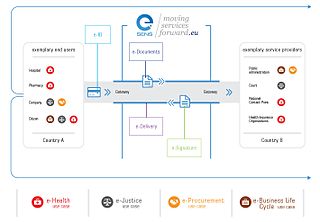Elements of the digital economy
The Digital Economy consists of all sectors making extensive use of digital technologies (i.e. their existence depends on digital technologies). [22] However, digitalization spans many economic sectors, making it far from trivial precisely delimit the digital economy within the entire societal economy [23]
A narrow definition would typically just encompass core digital sectors that refers to the provisioning of digital technologies, products, services, infrastructure, and solutions, as well as all forms of economic activities that are completely dependent on digital technologies and data elements. This includes key sectors like information and communication technology (ICT), [24] but also other economic activities such as internet finance and digital commerce that are not seen as a part of the ICT-sector.
Broader definitions also include industrial digitalization, i.e. the production quantity and efficiency improvement brought about by the application of digital technology in traditional industries, as an important extension of the digital economy into the wider societal economy. [23] Examples of industrial digitalization in traditional sectors include remote sensing, automated farming equipment, GPS-route optimization, etc. However, few studies include industrial digitalization in the digital economy.
Information technology
The information technology (IT) sector of the U.S. now makes up about 8.2% of the country's GDP and accounts for twice its share of the GDP as compared to the last decade. 45% of spending on business equipment are investments in IT products and services, which is why companies such as Intel, Microsoft, and Dell have grown from $12 million in 1987 to more than half a billion in 1997. [25] The widespread adoption of ICT combined with the rapid decline in price and increase in the performance of these technologies, has contributed to the development of new activities in the private and public sectors. These new technologies provide market reach, lower costs, and new opportunities for products and services that were not needed before. This changes the way multinational enterprises (MNE) and startups design their business models. [26]
Digital platforms
A digital platform operator is an entity or person offering an online communication service to the public based on computer algorithms used to classify content, goods, or services offered online, or the connection of several parties for the sale of goods, the provision of a service, or the exchange or sharing of content, goods, and services. [27]
Most of the largest digital platform companies are located in either the United States or China. [7]

Digital trade
In the U.S. in the 1990's, the Clinton Administration proposed The Framework for Global Electronic Commerce. It contained the promotion of five principles used to guide the U.S. government's actions towards electronic commerce so that the digital economy's growth potential remains high. These five principles include the leadership of the private sector, the government avoiding undue restrictions on e-commerce, limited government involvement, the government's recognition of the Internet's unique qualities, and the facilitation of e-commerce on a global basis. [25]
Governments have primarily restricted digital trade through three means: [7]
- Data flow restrictions: regulations that require that companies store data (e.g. personal information, business records, financial data, government data) in a particular country or go through a process before transferring the data abroad. For example, the EU's GDPR law only permits transfers of data on EU individuals to countries that have implemented certain data privacy safeguards and been certified by the EU.
- Data localization requirements: regulations that require that data be stored on servers within a country
- Digital services taxes: taxes on revenues from the sale of digital services or goods (e.g. online sales, digital advertising, e-commerce, data, streaming). By 2022, 29 countries had digital service taxes.
Gig economy
Gig work is labor that consists of temporary and flexible jobs usually done over delivery apps and rideshare services such as Grubhub, Uber, Lyft, and Uber Eats. It can be desirable to those who want more flexibility in their schedule and can allow workers to make additional income outside of their traditional jobs.
Most gig work supplements workers' traditional jobs. The full size of the gig economy and number of workers is not yet known. Katz and Krueger estimated that only 0.5% of gig workers make most of their income off of platforms like Uber, Lyft, Grubhub, and DoorDash. [28] Since these workers are considered independent contractors, these companies are not responsible for giving its workers benefits packages like it would for regular full-time employees. This has resulted in the formation of unions between gig and platform workers and various reforms within the industry. Blockchain and Tokenized equity-sharing gig economy platforms or applications are being developed to accelerate the gig economy as a full fledged digital economy contributor using new technologies.
Impact on retail
The digital economy has had a substantial impact on retail sales of consumer product goods. One effect has been the fast proliferation of retailers with no physical presence, such as eBay or Amazon. [29] Additionally, traditional retailers such as Walmart and Macy's have restructured their businesses to adapt to a digital economy. [30] Some retailers, like Forever 21, have declared bankruptcy as a result of their failure to anticipate and adapt to a digital economy. [31] Others, such as Bebe stores have worked with outside vendors to completely convert their business one that is exclusively digital. [32] These vendors, such as IBM and Microsoft, have [33] enabled smaller retailers to compete with large, multi-national established brands. [34]













